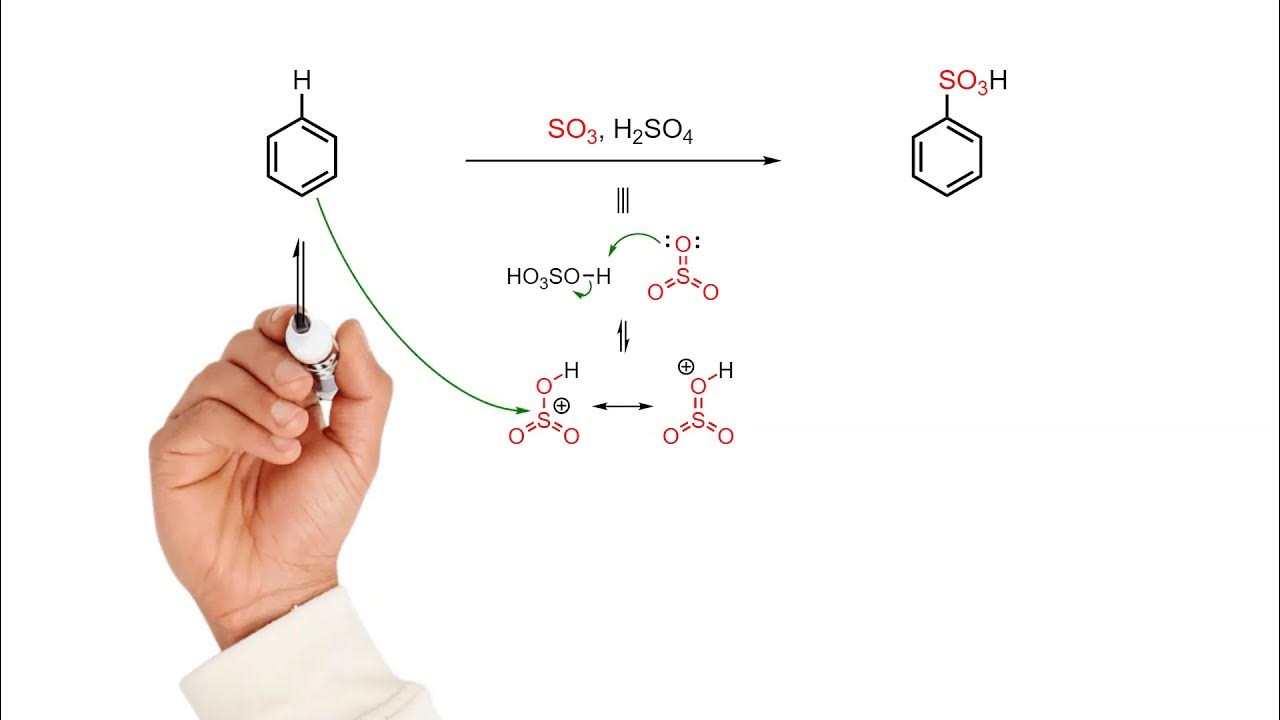13: Nitration of Benzene - Mechanism
Summary
TLDRThis video explains the nitration mechanism of benzene, where benzene reacts with concentrated nitric and sulfuric acids to form nitrobenzene and water. The process involves three main steps: 1) the generation of the electrophile, NO2+, through the reaction of nitric and sulfuric acids; 2) the electrophile attacking the benzene ring, causing a temporary negative charge; and 3) the removal of a proton (H+) to restore the aromaticity of the ring. The sulfuric acid acts as a catalyst, ultimately regenerating at the end of the reaction.
Takeaways
- 😀 The nitration of benzene involves a reaction with concentrated nitric acid and sulfuric acid to produce nitrobenzene and water.
- 😀 This process is an example of an electrophilic substitution reaction, where an electrophile substitutes a hydrogen atom in the benzene ring.
- 😀 The nitrating mixture (nitric acid and sulfuric acid) plays a critical role in generating the electrophile, which is the nitronium ion (NO2+).
- 😀 Sulfuric acid acts as a catalyst in this reaction and helps generate the electrophile from nitric acid.
- 😀 The electrophile generated in the reaction is the nitronium ion (NO2+), which is positively charged.
- 😀 The first step in the mechanism involves the formation of the electrophile through the reaction of sulfuric acid and nitric acid.
- 😀 The second step involves the electrophile attacking the benzene ring, where a negative charge is temporarily generated on the ring to form a bond with the electrophile.
- 😀 The third step involves the removal of a proton (H+), which regenerates the catalyst (H2SO4) and results in the substitution of a hydrogen atom by the nitro group (NO2).
- 😀 The removal of the proton results in the formation of nitrobenzene, where one hydrogen from the benzene ring is replaced by the NO2 group.
- 😀 The process is an example of how sulfuric acid is used as a catalyst in electrophilic substitution reactions, and it is regenerated at the end of the reaction.
Q & A
What is the main reaction in the nitration of benzene?
-The main reaction involves benzene reacting with concentrated nitric acid and concentrated sulfuric acid to produce nitrobenzene and water as a by-product.
Why is the nitration of benzene considered an electrophilic substitution reaction?
-It is considered an electrophilic substitution reaction because the electrophile substitutes one of the hydrogen atoms on the benzene ring.
What is the role of sulfuric acid in the nitration of benzene?
-Sulfuric acid acts as a catalyst in the reaction, helping to generate the electrophile (NO2+) from nitric acid. It is regenerated at the end of the reaction.
What is the nitrating mixture in the nitration of benzene?
-The nitrating mixture is a combination of concentrated nitric acid and concentrated sulfuric acid, which is used to generate the electrophile for the reaction.
What is the electrophile generated during the nitration of benzene?
-The electrophile generated is the nitronium ion (NO2+), which is positively charged and attacks the benzene ring.
What happens during the generation of the electrophile in the reaction?
-Sulfuric acid reacts with nitric acid to produce the nitronium ion (NO2+), bisulfate ion (HSO4−), and water. The NO2+ ion is the electrophile that will attack the benzene ring.
What is the significance of the hydrogen atoms on the benzene ring in this mechanism?
-Each carbon on the benzene ring initially has a hydrogen atom. During the reaction, one hydrogen atom is replaced by the electrophile, but the hydrogen atoms are not explicitly written unless they are part of the mechanism.
How does the electrophile attack the benzene ring in the nitration mechanism?
-The electrophile (NO2+) attacks the benzene ring, and a pi electron from the ring shifts to a position, forming a bond with the electrophile. This creates a negatively charged carbon in the ring.
What happens after the electrophile bonds with the benzene ring?
-After the electrophile bonds with the benzene ring, the resulting structure has a positive charge on the carbon where the electrophile is attached. This charge is stabilized by the movement of electrons within the ring.
What is the final step in the nitration mechanism of benzene?
-The final step involves the removal of a proton (H+), which restores the aromaticity of the benzene ring, resulting in the formation of nitrobenzene. The proton combines with the bisulfate ion (HSO4−) to regenerate sulfuric acid.
Outlines

Cette section est réservée aux utilisateurs payants. Améliorez votre compte pour accéder à cette section.
Améliorer maintenantMindmap

Cette section est réservée aux utilisateurs payants. Améliorez votre compte pour accéder à cette section.
Améliorer maintenantKeywords

Cette section est réservée aux utilisateurs payants. Améliorez votre compte pour accéder à cette section.
Améliorer maintenantHighlights

Cette section est réservée aux utilisateurs payants. Améliorez votre compte pour accéder à cette section.
Améliorer maintenantTranscripts

Cette section est réservée aux utilisateurs payants. Améliorez votre compte pour accéder à cette section.
Améliorer maintenantVoir Plus de Vidéos Connexes
5.0 / 5 (0 votes)






